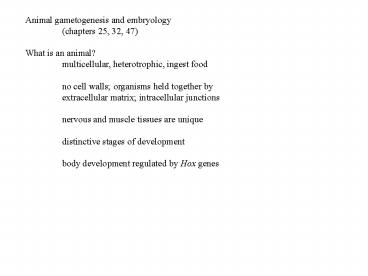Animal gametogenesis and embryology - PowerPoint PPT Presentation
1 / 15
Title:
Animal gametogenesis and embryology
Description:
Animal gametogenesis and embryology (chapters 25, 32, 47) What is an animal? ... nervous and muscle tissues are unique. distinctive stages of development ... – PowerPoint PPT presentation
Number of Views:595
Avg rating:3.0/5.0
Title: Animal gametogenesis and embryology
1
Animal gametogenesis and embryology (chapters
25, 32, 47) What is an animal? multicellular,
heterotrophic, ingest food no cell walls
organisms held together by extracellular matrix
intracellular junctions nervous and muscle
tissues are unique distinctive stages of
development body development regulated by Hox
genes
2
What is a Hox gene? Contains a homeobox that
enables it to bind to DNA as a transcription
factor (3 ?-helices) Remainder of the protein
helps determine which gene it regulates Some of
these gene products help regulate body part
development (homeotic genes) So far, homeotic
genes have been found only in animals
3
Model animals Drosophila, nematodes
4
Animals were traditionally classified based
on anatomy (body plans) and embryology New
approaches may modify old dichotomies I.
parazoa vs metazoa (eumetazoa) presence or
absence of true tissues II. radial vs bilateral
symmetry cephalization germ layers- radiata
have two, bilaterals three
5
Germ layers seen during gastrulation ectoderm-
skin, nervous system endoderm- (archenteron)-
digestive system, liver, lungs mesoderm-
muscles, other internal organs
6
III. Body cavity (of bilaterials) acoelomate
(flatworms) pseudocoelomate (rotifers and
roundworms) coelomates- body cavity completely
lined by mesoderm tissue Purpose of body
cavity? hydrostatic skeleton in
invertebrates growth, development and
positioning of internal organs
7
(No Transcript)
8
Protostomes vs deuterostomes
9
Stages of animal development fertilization
cleavage gastrulation (formation of germ
layers) organogenesis
10
Cleavage distributes cytoplasm of zygote into
many smaller cells Cells in most animals have
polarity vegetal pole (yolk) animal pole (very
little yolk) yolk is especially prominent in
eggs of birds, reptiles, many fishes and
insects affects cleavage- incomplete
(meroblastic) vs complete (trophoblastic)
11
(No Transcript)
12
Sea urchin gastrulation
13
(No Transcript)
14
(No Transcript)
15
(No Transcript)































